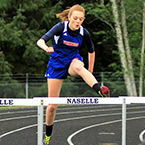Super Glue Makes Removing Venous Malformations Easier and Less Risky
We pioneered a way to get rid of painful, disfiguring veins with less risk and almost no recurrence – using super glue.
Published in Connection magazine, Fall 2016
 Born with a cluster of extra veins in her tongue that swelled larger and larger as she grew, Piper Canning, 10, of Post Falls, Idaho, no longer has to worry about whether she’ll be able to swallow, speak and breathe normally – thanks to a life-changing procedure pioneered by Seattle Children’s Vascular Anomalies team.
Born with a cluster of extra veins in her tongue that swelled larger and larger as she grew, Piper Canning, 10, of Post Falls, Idaho, no longer has to worry about whether she’ll be able to swallow, speak and breathe normally – thanks to a life-changing procedure pioneered by Seattle Children’s Vascular Anomalies team.
When Christina Canning started nursing her newborn daughter, she noticed something odd: the tiny girl’s tongue was partly black. Doctors thought it was a birthmark. As Piper grew, her tongue was a normal pink on one side and purple on the other – a characteristic, her parents told her, that made her unique. But by the time she was 7, her tongue had turned so lumpy – and her tonsils so large – that her dentist worried she might soon have trouble breathing.
“Sure enough, she started snoring and flailing around at night,” recalls Canning. “We agreed the tonsils had to go.”
Two years later, her tongue was so swollen that teachers started calling Canning, concerned that Piper might accidentally bite it and they wouldn’t be able to stop the bleeding.
“Her tongue never hurt and she was eating and talking just fine, but we knew something needed to be done,” Canning explains. “The doctor who removed Piper’s tonsils said he’d heard of a surgeon at Seattle Children’s who might be able to help.”
“It’s critical we get the word out about this new procedure, because there are still thousands of families throughout the country who are being told ‘there’s nothing more we can do.’ ”
A tangled web
That surgeon was Dr. Jonathan Perkins, a national expert in treating issues of the veins and arteries in the head and neck that are known as vascular anomalies. He confirmed that the 9-year-old had a spaghetti-like cluster of blood-filled veins in her tongue called a venous malformation. These surplus clusters are usually present at birth and often grow as the child gets bigger, yet they have no function in the body and can be disfiguring and painful. If accidentally bumped or cut, they bleed profusely.
Even worse, removing a venous malformation is difficult, if not next to impossible.
“These things are like water balloons filled with tiny tubes of liquid,” explains Perkins. “If we puncture one while we’re trying to remove it, it drains and there’s nothing left to remove.”
When the puncture heals, the tube fills again with blood and the purplish mass usually returns to begin a new cycle of pain, disfigurement and impairment.
Better solutions needed
The first line of defense in treating venous malformations – sclerotherapy – hasn’t changed in more than 100 years. The treatment involves injecting detergent or other substances into the malformed veins to chemically injure their linings and shrink the veins, but there are many drawbacks: it must be done repeatedly, the patient must be under general anesthesia, recovery is painful and the detergent causes inflammation that can damage the skin or mucous membranes. Even more troubling, the most effective substance to shrink a malformation is absolute alcohol, but it’s also the most caustic to normal tissue and can potentially travel through a child’s veins to their heart.
“If the dose is big enough, it can stop the patient’s heart and cause death,” says Perkins. “That’s a big risk we’re not comfortable taking.”
Laser therapy, which “cooks” the malformed veins from the inside, also requires repeated procedures under general anesthesia plus a painful recovery.
Surgery is usually the last resort because blood transfusions due to excessive bleeding are a risk and veins are slippery – trying to remove a cluster is like tugging on wet tissue paper.
115: Approximate number of glue embolizations done at Seattle Children’s
Teamwork and innovation
Perkins and his team were frustrated. They wanted to offer families a safer, less painful treatment with better than a 50% chance the veins wouldn’t grow back. When Perkins told his colleague Dr. Raj Ghodke about a particularly vexing case where conventional treatments had failed to eliminate a large mass of veins on a child’s neck, a light bulb went on for Ghodke. He considered how he’d used medical-grade super glue to treat leaking brain aneurysms and wondered if a similar technique might work to remove venous malformations.
“It seemed like a great solution,” remembers Perkins. “Raj had worked with the glue before, so he knew how to control the injection into these channels of disorganized veins. And once the glue turned solid (about 20 minutes), we figured it would create a cast-like form that I could clearly identify and cleanly remove. I thought, ‘why not try it?’”
The results have been amazing. Together the two doctors were able to get rid of the mass on Piper’s tongue, and since 2013, they’ve removed venous malformations from the head and neck of dozens of children who had run out of other options.
“It’s the first thing we’ve hit on that allows us to remove localized venous malformations in one shot and it’s rare that they grow back,” says Perkins. “It’s been so successful compared to the other treatment options that it’s become our new standard of care at Seattle Children’s.”
Now Ghodke, an interventional radiologist at Seattle Children’s, and Perkins are on a mission to get the word out about the new procedure’s effectiveness. “There are still thousands of families throughout the country who are being told ‘there’s nothing more we can do’ after conventional treatments fail,” says Perkins.
In 2013, Perkins and Ghodke reported their novel technique in a prominent surgical journal, and they continue to train peers and present the procedure at professional conferences.
Extending the standard
 Dr. Greg Kinney is a neurophysiologist who makes sure critical facial nerves don’t get nicked or cut when venous malformations on the head or neck are removed.
Dr. Greg Kinney is a neurophysiologist who makes sure critical facial nerves don’t get nicked or cut when venous malformations on the head or neck are removed.
In 2014, Ghodke shared the new glue embolization technique with Drs. Giri Shivaram and Eric Monroe (Seattle Children’s interventional radiologists specializing in vascular anomalies), who began applying it to venous malformations of the extremities. It quickly became a game-changer for patients like Avery Strozyk, 16.
An avid athlete, Avery woke up with so much pain and swelling on her left foot that she played a softball tournament with her cleat unlaced. She iced the top of her foot, thinking she’d bruised it. But the pain didn’t go away and her sports medicine doctor in Chehalis, Wash., quickly ran out of options. Avery was referred to Dr. Antoinette Lindberg, an orthopedic surgeon at Seattle Children’s.
“It felt like someone was stabbing my foot with a knife. Every time I’d try to run, my foot would say no,” remembers Avery. “I had to give up sports, which was the toughest thing I’ve ever done. All I could do was lay around. I got so depressed, I could barely function.”
After two rounds of sclerotherapy, several hospital stays, daily pain meds and months on crutches, the inflamed mass of veins grew even bigger and started to cut off the blood supply to her foot.
“If Avery had been treated anywhere else she might have lost her foot,” says Lindberg.
Back in the game
 Stabbing pain in her left foot made it nearly impossible for Avery Strozyk, 16, to walk until the innovative procedure at Seattle Children’s got the teen from Raymond, Wash., back on track.
Stabbing pain in her left foot made it nearly impossible for Avery Strozyk, 16, to walk until the innovative procedure at Seattle Children’s got the teen from Raymond, Wash., back on track.
Instead, Avery went to interventional radiology under anesthesia where flat-screen displays showed scans of the malformation. Through real-time imaging, Monroe watched his needle enter Avery’s foot as he injected the medical-grade super glue into the extra veins, taking pains to keep it from traveling into normal veins – where even the tiniest amount can cause blockage or even migrate to the heart and lungs.
After he finished with the glue, Monroe made a 3-D image of the malformation from a CT scan with low-dose radiation and sent it to Lindberg as Avery was rolled down the hall to the operating room.
Lindberg used the image as a map to guide the delicate surgery where she removed the glue-hardened malformation.
“The cluster of veins had wrapped itself around nerves and created a tangled mess,” explains Lindberg. “That’s why Avery had such excruciating pain every time she moved her foot.”
Three days after the glue embolization, Avery was off crutches. Within a week she was walking normally. In just two months, she was cleared for track and back to jumping hurdles, running relay and throwing the discus.
“Without Dr. Lindberg, Dr. Monroe and Dr. Shivaram, I don’t know where I’d be right now,” she says. “They gave me inspiration and saved my foot. They are truly my heroes and I can’t thank them enough.”